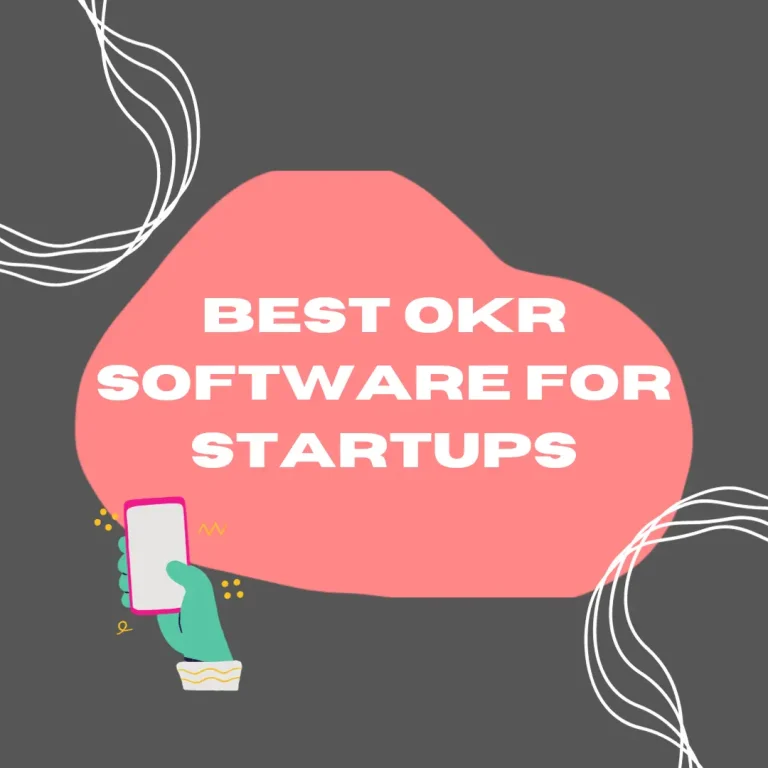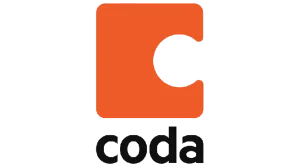OKR is a goal-setting framework that helps organizations and individuals define and track their objectives and key results in a clear and measurable way. It was popularized by companies like Intel and Google and has become widely adopted in various industries.
OKR software is crucial for startups as it helps them efficiently set, track, and manage their Objective and Key Results (OKRs). In the fast-paced startup environment, the OKR platform provides centralized goal visibility, promotes alignment across teams, enables real-time progress tracking, and offers data-driven insights, all of which enhance focus, collaboration, and adaptability, leading to accelerated growth, better decision-making, and streamlining.
What is OKR Software?
OKR (Objectives and Key Results) software is a tool designed to help individuals, teams, and organizations set, track, and manage their goals and objectives using the OKR framework.
Typically, you won’t come across a standalone OKR software. Instead, the implementation of OKRs is commonly found integrated within Project Management platforms. These comprehensive tools offer a broader range of features beyond OKRs, such as task management, team collaboration, and reporting, making it convenient for organizations to manage both project workflows and goal-setting in a unified environment.
Best OKR Software for Startups 2023
ClickUp
Scoutups Opinion
ClickUp will not only manage your tasks and projects but also make it easy for you to get them done! You can also set your goals and see the timeline but also save documents and create whiteboards. Just register to fall in love.
ClickUp is a project management and productivity software platform that offers a wide range of features to help teams and individuals organize their work, collaborate effectively, and increase productivity. It is designed to be highly customizable and can adapt to various workflows and use cases.
ClickUp’s flexibility and extensive feature set make it suitable for a wide range of industries and teams, from small startups to large enterprises. It can be adapted to various project management methodologies, making it a versatile tool for improving team productivity and organization.
Here are some of the key features of ClickUp:
- Task Management: ClickUp lets you create, assign, prioritize, and set due dates for tasks and subtasks. It facilitates efficient communication via task comments.
- Custom Statuses: Customize task statuses to match your workflow, creating as many as needed with any desired names.
- Time Tracking: Built-in time tracking helps measure task durations and monitor time allocation.
- Project Management: Visualize progress using Gantt charts and project timelines while managing task dependencies.
- Dashboards: Create custom dashboards with charts, task lists, and project statuses to visualize teamwork and productivity.
- Integration: Integrate ClickUp with various tools like Google Calendar, Slack, Dropbox, GitHub, etc., for centralized work management.
- Reminders: Set task reminders to prevent overlooking important tasks.
- Automation: Automate repetitive tasks to enhance efficiency and streamline workflows within ClickUp.
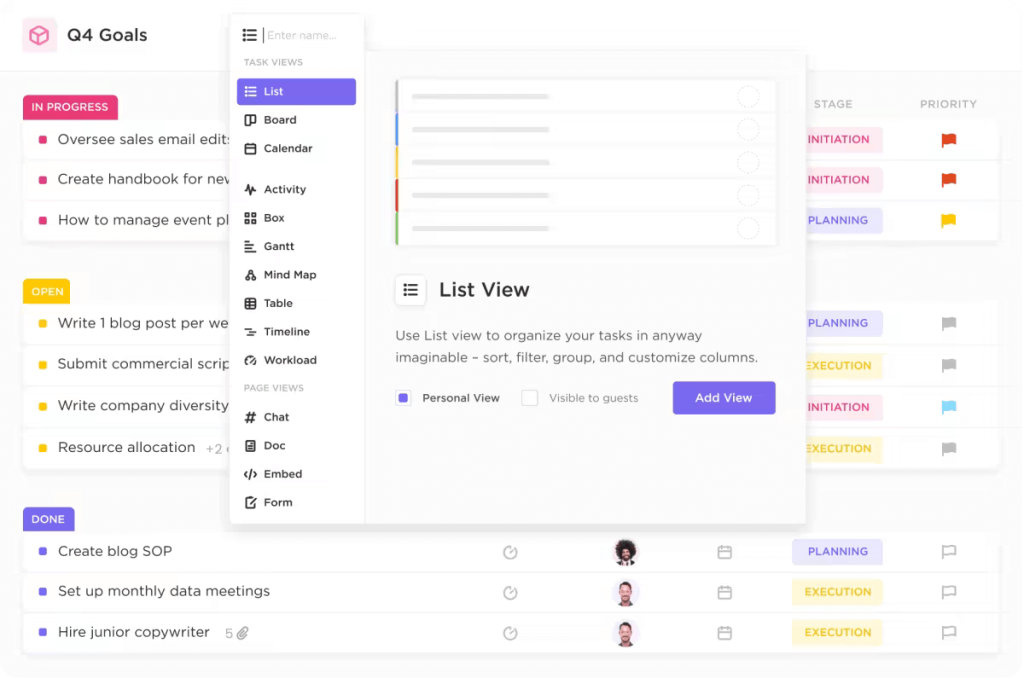
Pros
- Free Forever Plan: ClickUp offers a free plan for individuals, making it accessible for solo users.
- Accessibility: ClickUp can be accessed at any time on any device.
- Advanced Task Management: ClickUp provides advanced task management tools that can handle complex projects efficiently.
- Customization & Automation: Users benefit from pre-built templates, multiple view options, and a wide range of automation features.
- Updates: Regular updates of streamlined productivity.
Cons
- Unintuitive Design: Newcomers might find it difficult to learn. ClickUp offers so many tools that setting everything up might be quite time-consuming and complex.
- Time Tracking Issues: Some users have reported glitches with the time tracking feature.
- Delayed workflow: Some features work with a delay.
OKR implementation
ClickUp is a powerful tool that can help you implement the OKR Framework into your startup. ClickUp’s OKR Framework Template is a simple but influential way to ensure that your startup stays on track. Here are 6 steps to help you get started with creating your own OKR framework:
- Identify Objectives: Brainstorm and define overarching objectives. Use ClickUp’s Docs to list the main objectives.
- Set Measurable Key Results: Create specific, measurable, achievable key results (KRs). Translate objectives into measurable KRs. Utilize ClickUp tasks to outline key results.
- Establish Timeline and Milestones: Define a timeline with measurable milestones. Track progress using ClickUp’s Milestones.
- Assign Tasks: Delegate tasks to team members for each goal. Assign tasks through ClickUp.
- Monitor Progress: Regularly monitor goal and key result progress. Use ClickUp’s Dashboards for an overview.
- Celebrate Achievements: Celebrate successes and acknowledge team efforts. Set reminders with ClickUp’s recurring tasks.
Check out more on ClickUp’s OKR Framework blog post.
Pricing (Yearly)
- FREE FOREVER: for personal use – 0$
- UNLIMITED: best for small teams – 7$ per member per month
- BUSINESS: best for mid-sized teams – 12$ per member per month
- ENTERPRISE: best for many large teams – contact sales
Monday
Scoutups Opinion
Monday.com is a powerful work management platform that excels in providing flexibility and customization for diverse team needs. Its visual interface and robust features make it a valuable tool for project management and collaboration. It might be a game-changer for your business!
Monday is a work operating system and collaboration platform designed to help teams and organizations plan, track, and manage their work effectively. It offers a visual and customizable interface that allows teams to create, organize, and automate workflows, making it suitable for various use cases across different industries.
Monday’s versatility and user-friendly interface make it a valuable tool for teams of all sizes and industries. It can be adapted to various project management methodologies and serves as a centralized platform for planning and tracking work.
Here are some key features of Monday.com:
- Customizable Workspaces: Teams can create and organize boards for different projects, departments, or workflows with tailored layouts.
- Visual Boards: Utilize Kanban boards, Gantt charts, and timelines for effective task, project, and process planning and tracking.
- Task and Project Management: Create tasks, assign them, set due dates, and manage project dependencies and subtasks.
- Automation: Streamline repetitive tasks with automation, creating triggers and actions based on specific events.
- Communication and Collaboration: Foster team communication with comments, mentions, and notifications within the platform.
- Time Tracking: Measure task and project durations with built-in time tracking for accurate billing and resource allocation.
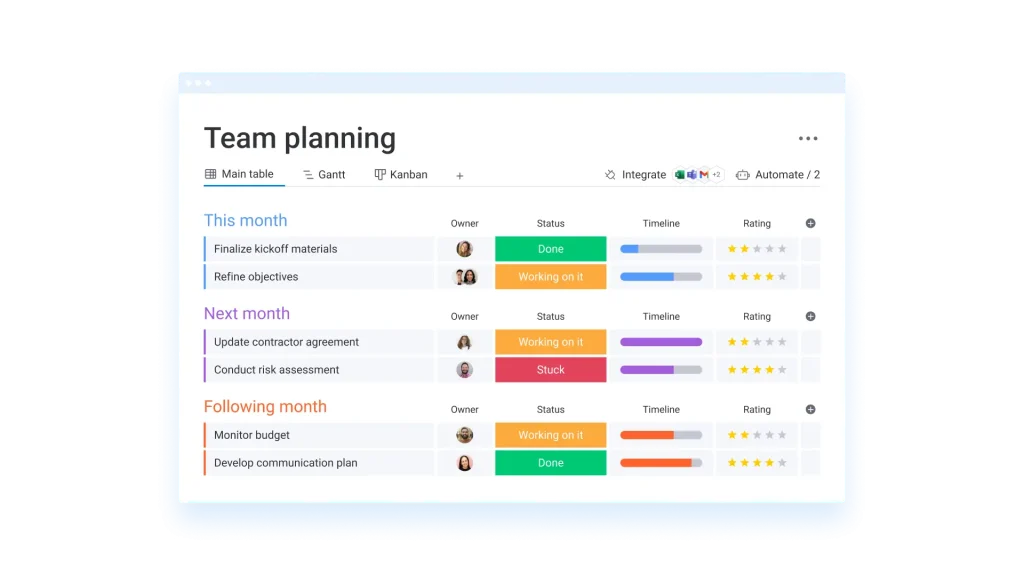
Pros
- User-friendly Interface: A straightforward and simple interface helps newcomers to settle in quickly.
- Customer Service: Many users say that the speed and quality of their assistance to customers is unparalleled.
- Customizability: This software lets you customize modules, visuals, workflows, etc.
- Desktop Notifications: A great way to reduce clutter in your inbox.
- Automation: This feature helps you organize everything faster and with ease.
Cons
- Limited Integration: There is no native integration with Google Calendar or any other similar platform.
- Cost: Some users find Monday to be relatively expensive, especially for small teams or organizations with limited budgets.
- Glitches: Some users say that some of the functions tend to glitch sometimes.
OKR implementation
Using monday.com, planning out your OKR workflow has never been easier! If you’ve been looking for a solution to manage your StartUp objectives with the OKR Framework, then monday.com is here for you. Here’s how to start:
- Set Up an OKR Board: Create a new board within your workspace, which will serve as the central hub for OKR management.
- Add Granularity With Subitems: To introduce a finer level of detail and enhance comprehension of the tasks required to accomplish each key result, utilize subitems.
- Measure Key Results: Use different formulas to make your key results progress visible.
- Visually Display OKR Data: You can easily see your objectives laid out using the Chart View.
- Create OKR Reports Using Dashboards: To consolidate OKR data from various boards into a single visual summary, Monday created a dedicated dashboard. This acts as an excellent tool for quickly grasping various OKR metrics in one glance.
Pricing (Yearly)
- FREE: up to 2 users – 0$
- BASIC – 8$ per user per month
- STANDARD – 10$ per user per month
- PRO – 16$ per user per month
- ENTERPRISE – contact sales
Taskade
Scoutups Opinion
Taskade = Project management + AI. You will find everything you need to manage your projects and tasks, all with the help of AI. You can also create docs and mind mapping. The best tool for those who want to use AI to increase productivity.
Taskade is a productivity platform powered by artificial intelligence (AI) that functions as a virtual assistant for both individuals and teams. It provides a unified workspace where all tasks and activities are synchronized, offering a complete solution for managing tasks, taking notes, creating mind maps, and much more.
If you are looking for helpful OKR Software for your startup, Taskade can be an exciting choice for you. Embrace the power of AI to track your objectives and key results as efficiently as possible.
Some of Taskade’s best features:
- Taskade enables users to generate dynamic to-do lists, flowcharts, mind maps, and more, while offering various project views (lists, boards, calendars, mind maps, org charts, and action views).
- It features an AI assistant for brainstorming and task coordination.
- Taskade provides a structured outlining experience that mimics the brain’s natural organization.
- Utilizing AI, Taskade generates ideas, converts them into action items, and tracks progress across different views.
- Users can share projects limitlessly with guests, clients, and teams for collaboration.
- Taskade allows for personalization of your home screen for easy access to tasks, projects, and workflows.
- It includes an integrated calendar to help plan weeks or months based on your tasks and projects, following the GTD principle of regular reviews and planning.
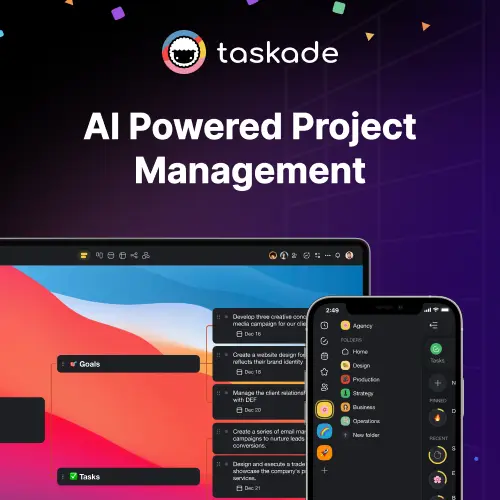
Pros
- Intuitive Interface: Taskade offers a simple and user-friendly interface so it’s easy to implement.
- Customizable Templates: Users can tailor templates according to their requirements.
- Flexibility: Ability to manage projects of all sorts, both professional and personal.
- Wide Range of Templates: Various templates let users meet personal needs or get ideas of the software usage.
- Collaboration: Taskade allows users to share tasks and projects with team members effortlessly.
Cons
- Coloring: Some users state that the interface is too colorful, making the design a little bit childish.
- Internet Needed: You can’t use this software offline.
OKR implementation
The Team OKR Tracker by Taskade is a powerful tool that makes setting and tracking team goals easy. It’s a simple yet super effective way to make sure everyone’s goals match up, decide what to do first, and see how you’re doing along the way. Here’s how to get started:
- Begin by creating a new project in your Taskade workspace.
- Gather your team to discuss objectives and key results for alignment.
- Easily track progress against goals using the template.
- Adjust your strategy based on progress, whether daily, weekly, or monthly.
- Celebrate successes to acknowledge hard work and maintain motivation.
Learn more about this fantastic tool on Taskade’s blog post.
Pricing (Yearly)
- FREE: for personal use – 0$
- STARTER: up to 3 users – 4$ per month billed annually
- PLUS: up to 5 users – 8$ per month billed annually
- PRO: up to 10 users – 19$ per month billed annually
- BUSINESS: up to 25 users – 49$ per month billed annually
- ULTIMATE: up to 50 users – 99$ per month billed annually
Notion
Scoutups Opinion
Ease of use and endless possibilities, best describes Notion. The all-in-one workspace that adapts to your unique needs – manage projects, organize documents, and even collaborate, all from one easy-to-use platform. One of the best productivity apps ever created, Scoutups favorite!
Notion is an all-in-one productivity software and collaboration platform that provides a wide range of tools and features for individuals and teams to organize, manage, and share information.
Notion is known for its flexibility and adaptability, making it popular among individuals, teams, and organizations for a wide range of use cases, from personal note-taking to project management and beyond. Users can structure their workspace in a way that best suits their needs, making it a versatile tool for various workflows and tasks. Notion is more than OKR Software, so if you are looking for something flexible, it might meet your expectations.
Key features of Notion include:
- Notes and Documents: You can create and edit documents and notes with a rich-text editor, similar to word processing software.
- Databases: Notion allows you to create structured databases with various data types, including text, numbers, dates, and more. These databases can be used for tasks like project tracking, inventory management, or creating content calendars.
- Templates: Notion offers a wide range of templates for common use cases, such as to-do lists, meeting notes, project management boards, and personal journals.
- Task and Project Management: You can use Notion to create task lists, Kanban boards, and project timelines.
- Collaboration: Multiple users can collaborate in real time on Notion documents and databases. You can also comment on specific items, mention collaborators, and assign tasks.
- Customization: Notion is highly customizable, allowing users to design their own workspace, choose layouts, and create custom databases and views.
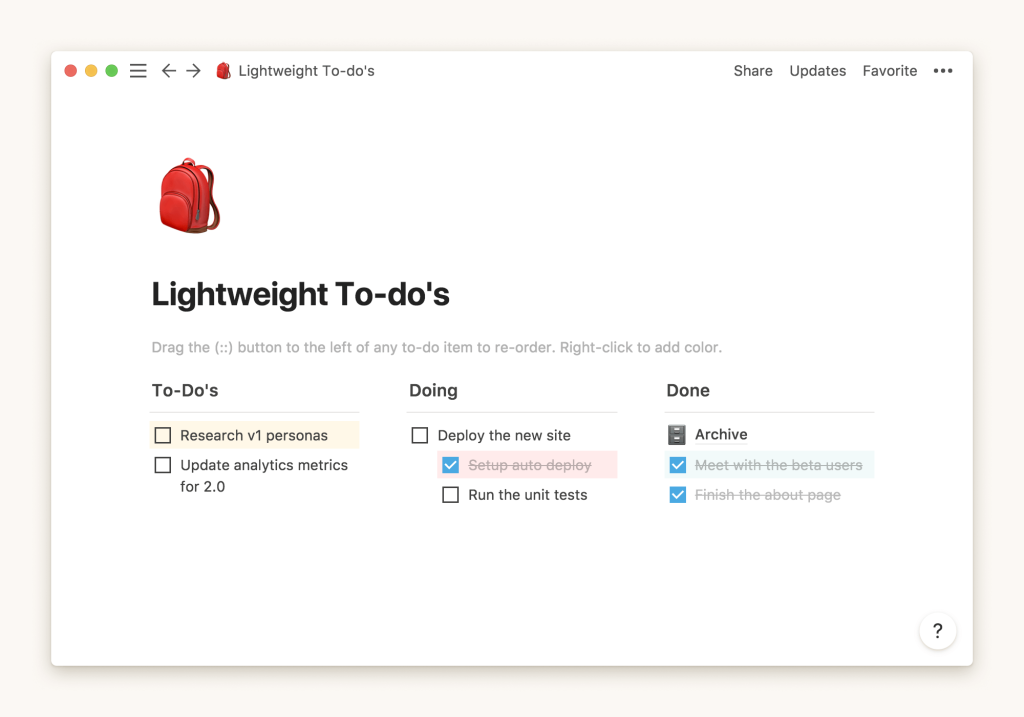
Pros
- Free Version: Notion offers a free version that comes with unlimited pages, allowing users to create extensive content without any cost.
- High Customizability: Users can tailor Notion to their specific needs, making it versatile for various tasks.
- Affordable Premium Plans: The premium plans are low-cost, making it accessible for a wider range of users.
- Collaboration & Sharing: Notion allows users to share their content with guests and team members, promoting teamwork.
- Flexibility & Versatility: Notion can be used as a note-taking app, task manager, project management tool, and much more.
Cons
- Mobile App Usability: Some users find the mobile app to be tedious and less user-friendly than desired.
- Security Concerns: Plans designed for small businesses might lack essential security features, potentially making sensitive data vulnerable.
- Overwhelming Interface: While Notion is a feature-rich platform, its learning curve can be steep for newcomers.
OKR implementation
Use Notion to identify and organize your objectives, track your team’s progress, and assess the results. Elevate your task management to new heights with Notion’s dynamic OKR Tracker. Here’s how to do OKRs in Notion:
- Create a Notion account and team workspace.
- Design a page with an OKR template or start from scratch.
- Start setting goals and ways to measure them.
- Add custom properties, dates, and relevant tasks.
- Invite team members and set their access permissions.
Check out more on Notion’s blog post.
Pricing (Yearly)
- FREE: for personal use – 0$
- PLUS: best for small groups – 8$ per user per month
- BUSINESS: best for companies – 15$ per user per month
- ENTERPRISE: best for entire organizations – contact sales
Coda
Scoutups Opinion
Coda is a versatile platform that seamlessly blends project management, spreadsheets, documents, and apps into one. Its customizable interface and rich integration capabilities empower teams to streamline their workflows. A game-changer for those seeking a unified workspace solution.
Coda is a collaborative document and productivity platform that combines documents, spreadsheets, and databases into a single tool. It’s designed to help teams and individuals create and manage a wide range of documents, workflows, and applications. Coda offers a unique approach to document creation and organization, allowing users to build interactive and customizable documents with a variety of features.
Coda’s unique combination of document editing, spreadsheet capabilities, and database functionality makes it a powerful tool for teams and individuals who need to create and manage complex documents, workflows, and applications in a collaborative environment. If you are looking for software that ensures good collaboration, customization, and the ability to create versatile documents and databases, Coda might be the best choice for your startup.
Here are some key features of Coda:
- All-in-One Doc: Coda consolidates text, data, and collaboration tools into a single, user-friendly platform.
- Customizable Building Blocks: It offers customizable building blocks to create tailored solutions as your team evolves.
- Project Management Tools: Coda excels in project management, offering intuitive roadmaps and interconnected tables.
- Knowledge Management: Coda supports knowledge management by structuring company information and facilitating shared experiences.
- Integration: Coda offers integrations with various third-party apps and services, allowing you to connect your startup’s data and processes.
- Templates: Pre-made templates are available for various scenarios, such as project management and team meetings.
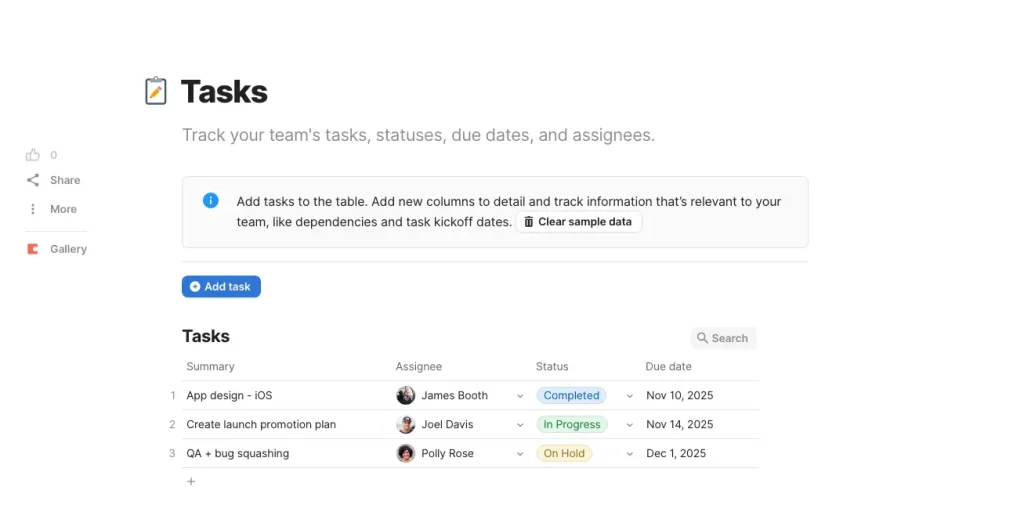
Pros
- One-Stop-Shop: Coda has been praised for its ability to consolidate various work processes into one platform, reducing the need to jump from one application to another.
- Flexibility: Users love Coda’s flexibility, allowing them to define roadmaps, scope projects, and even run personal blogs.
- Ease of Use: Coda is known for its user-friendly interface. Users can get up and running with Coda within minutes, creating useful documents and workflows.
- Value for Money: Given its powerful features and capabilities, users have found Coda to offer excellent value for money.
Cons
- Performance with Large Data: Some users have reported that Coda can become slow when dealing with a large amount of data.
- Lack of Advanced Statistical Analysis: Users have expressed a desire for more advanced statistical analysis options for their tables and charts.
- Limited Scalability: Some users have expressed concerns about Coda’s scalability, especially for larger teams or more complex projects.
OKR implementation
Coda is widely used by startups for brainstorming, setting, and tracking objectives and key results in a single document. It streamlines success by combining documents, tables, and apps, allowing you to align your team by updating progress and strategic direction in one place.
Coda has their own videos made for bringing OKRs to life. They consist of 4 steps: Structure, Team Views, Escalation, and Reflection. Go check them out here.
Pricing (Yearly)
- FREE: for getting started – 0$
- PRO: for scaling yourself & your team – 10$ per month per Doc Maker
- TEAM: for more powerful collaborations – 30$ per month per Doc Maker
- ENTERPRISE: for control, security, and support – custom price
Weekdone
Scoutups Opinion
Weekdone is a valuable tool for organizations focused on implementing the OKR framework. It offers a user-friendly platform for setting and tracking goals, fostering transparency, and promoting regular check-ins. If you are only interested in the OKR framework, then Weekdone is the best choice for your business.
Weekdone is a team management and goal-setting platform designed to help organizations and teams set objectives, track progress, and improve performance. It’s particularly focused on OKR (Objectives and Key Results) methodology.
Weekdone is particularly useful for organizations that follow the OKR methodology or want a platform that emphasizes goal-setting, progress tracking, and alignment of individual and team efforts with company objectives. It helps in fostering transparency, accountability, and improved performance within teams and organizations.
Here are some of the key features of Weekdone:
- Weekly Check-Ins: Encourages regular progress reporting toward objectives and KRs, fostering team transparency and accountability.
- Visual Dashboards: Provides real-time visual overviews of team and individual progress, aiding in goal assessment.
- Task Management: Offers basic task management capabilities alongside the primary focus on OKRs.
- Team Collaboration: Facilitates collaboration through comments, feedback, and progress discussions among team members.
- Integration: Integrates with third-party tools like Slack and Google Workspace for streamlined workflow and data sharing.
Pros
- Customizable Dashboard: Weekdone allows users to create and monitor their own individual goals and tasks, as well as those of their team.
- Automation: Weekdone has the ability to set reminders and notifications for upcoming deadlines or missed goals.
- Free Version: Weekdone is free forever for single users.
- Flexible & Clear Dashboard: This dashboard can be set up to display information in a variety of formats, such as graphs or charts, making it easy to see progress at a glance.
Cons
- Unintuitive Interface: Navigating through the software can be quite a hassle.
- App Performance: Some users state that the app works slowly.
OKR implementation
Weekdone’s OKR implementation process is tailored to the specific needs of organizations, particularly focusing on the OKR framework. They offer three distinct strategies for initially adopting OKRs, each with its own timeline and ongoing management tips. The choice of strategy depends on the size of the user base within the organization. To learn more, you can explore these strategies on their platform.
Pricing (Yearly)
- FREE: for up to 3 people
- PREMIUM: 3.75$ – 8$ per user per month depending on the number of users
OKR apps FAQ
What are OKRs?
OKRs are a way to set goals and measure progress. You have a main goal (Objective) and smaller tasks to achieve (Key Results). They help you stay focused, work together, and see how well you’re doing.
The OKR framework consists of two main components:
- Objectives: These are the high-level, aspirational goals that an individual, team, or organization aims to achieve. An Objective points out the areas you want your people to focus on and drive forward.
- Key Results: These are specific, measurable outcomes that are used to track progress toward achieving the objectives. Key Results are not activities but rather the results you hope to see.
The success of an Objective is measured by progress made on Key Results.
The more progress you or your team make on the Key Results, the closer you are to accomplishing your Objective. Here is an example of an OKR:
Objective: Increase the company’s trust among customers.
Key Result 1: Increase service quality rating by 1.5 or more.
Key Result 2: Invest an additional 5% of income into marketing.
Why startups should use OKR?
Startups should use OKRs because they help set clear goals (Objectives) and show how well you’re doing (Key Results). They keep everyone working together on important things and help you improve and grow faster. OKRs make startups better by making sure everyone is on the same page and moving in the right direction.
What are the Best Practices for Using an OKR Tool in a Startup?
- Start Simple: Once you begin, you shouldn’t overload your startup with too many Objectives and Key Results to avoid overwhelming your team and ensure a smooth implementation.
- Clear Objectives & Measurable Key Results: Make sure your Objectives are specific, inspiring, and well-defined. For that matter, your Key Results should be measurable and quantifiable, providing a clear way to track progress and success.
- Regular Updates: Encourage frequent updates on key results to keep everyone informed and engaged. Regular check-ins help ensure accountability.
- Adaptability: Be open to adjusting OKRs as circumstances change. Startups often face shifts, and your OKRs should be flexible enough to adjust evolving priorities.
- Focus on Value: Ensure that your OKRs drive meaningful impact. Prioritize initiatives that contribute directly to the startup’s growth and success.
- Regular Review: Book your time for regular reviews to evaluate progress, identify challenges, and make informed adjustments.
What is an OKR vs KPI?
OKRs (Objectives and Key Results) are like setting clear targets and steps to reach them. They focus on what you want to achieve and how to measure progress.
KPIs (Key Performance Indicators) are like measuring how well you’re doing in different areas, but they might not always be tied to specific goals. They show if things are going well, but not necessarily the exact steps to get there.
What are some examples of OKRs in startups?
Here are some examples of OKRs in a startup:
1. Objective: Improve Customer Satisfaction
- Key Result 1: Achieve a customer satisfaction rating of 4.5 stars or higher on average in the next quarter.
- Key Result 2: Respond to all customer inquiries within 24 hours.
- Key Result 3: Reduce the number of customer complaints by 20%.
2. Objective: Increase Revenue
- Key Result 1: Grow monthly revenue by 15% compared to the previous quarter.
- Key Result 2: Acquire 100 new paying customers within the next two months.
- Key Result 3: Launch a new pricing plan and have 50% of existing customers upgrade within three months.
3. Objective: Enhance Product Quality
- Key Result 1: Achieve a 90% or higher user satisfaction rate in post-launch surveys.
- Key Result 2: Resolve all critical bugs reported by users within two weeks.
What’s the difference between an OKR and MBO framework?
Both the OKR (Objectives and Key Results) and the MBO (Management by Objectives) framework involve goal-setting, but they have some differences.
OKRs are focused on setting specific objectives and measurable key results to track progress, promoting alignment and adaptability in fast-paced environments, like startups.
MBO, on the other hand, is a broader management approach that emphasizes collaboration between managers and employees to define objectives and performance expectations, often with a focus on employee development and appraisal.
While both aim to improve performance through goal-setting, OKRs are more dynamic and outcome-oriented, while MBO has a broader focus on management processes and employee growth. It makes OKRs a perfect choice for developing startups.
What to Look for in OKR Tools for Startups?
When you’re looking for the best OKR Software for startups, you should demand some features that will help your startup thrive with ease. Below are the top 5 components, that the best OKR software should contain:
- User-friendliness: Easy to use and navigate.
A user-friendly interface ensures that team members can quickly adopt the tool without spending excess hours mastering it. Intuitive navigation simplifies the OKR management process, allowing startups to focus on their goals rather than grappling with complex software.
- Scalability: Ability to grow with the startup.
As startups gather steam, their OKR tool should handle an increased amount of users, objectives, and data. A scalable solution ensures that the platform remains effective and efficient even as the startup’s operations and ambitions evolve.
- Integration capabilities: Compatibility with other tools and platforms.
Integration with existing tools such as project management or communication platforms improves workflow efficiency. The OKR tool should work harmoniously with other essential software.
- Reporting and analytics: Insightful data representation.
Effective reporting and analytics provide startups with valuable insights into goal progress and performance trends. Look for a tool that offers customizable reports, visualizations, and data-driven insights to facilitate informed decision-making.
- Pricing: Cost-effective solutions for startups.
Budget-friendly pricing options tailored for startups are crucial. The tool should provide value without weakening the startup’s finances, enabling access to essential features without compromising quality.

